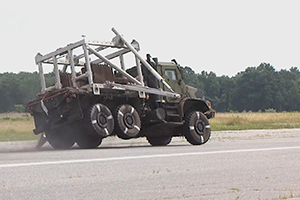Finding a Safe Balance
Brian S. Hill
Chief, Automotive Instrumentation Division, Automotive Directorate
An MTVR with outriggers undergoes a sine-with-dwell test at Phillips Army Airfield.
Military personnel need continually improved equipment. ATC testing takes vehicles to the point of no return…and back.
As ATC test professionals, we are often asked why we are still testing Humvees, Abrams tanks and other systems that have been used in the field for decades. Why do they need to climb the slopes again? Why do we keep doing brake stops? What most people do not realize is that those systems are constantly updated, improved or reengineered to improve their reliability and usefulness for our Soldiers. Each modification changes the vehicles, sometimes drastically, with up-armor kits, more powerful engines, larger payload capacities and so on. If the vehicle will be used in a risky tactical or combat situation, its performance must be fully understood before it is sent to the troops. A truck driven in a convoy at 70 mph in theater must be able to stop quickly, swerve at a moment’s notice and not overheat while climbing mountains.
The Automotive Instrumentation Division specializes in testing these systems, and the most aggressive exercises performed may be steering and handling maneuvers. These tests use state-of-the-art instrumentation packages to measure parameters, and the vehicles are fitted with outriggers for safety. Outriggers are designed in-house with the Instrumentation Development Division and then fabricated by the Experimental Fabrication Division. Each set is custom built and scalable, with movable weight sets to mimic any payload the vehicle might be required to handle in the field.
Sine-with-dwell maneuver testing has been performed on all commercial vehicles sold after September 2011. The test involves accelerating the vehicle to approximately 50 mph with no steering or braking, coasting in the highest gear and robotically applying a steering control to create a dramatic steering maneuver. The roll angle of the vehicle is measured to determine whether it passed or failed the test. Currently, each new commercial vehicle is equipped with an electronic stability control system.
In military vehicle testing, outriggers are needed to perform aggressive automotive tests that push a vehicle past its design limits while mitigating risk to the operator and vehicle. During high-speed steering maneuvers, any vehicle will eventually reach a point of instability. If this condition is not corrected quickly, the vehicle will roll over. Outriggers prevent that catastrophe from damaging man or machine. Before an outrigger-equipped vehicle arrives at the ATC test course, the outriggers are stringently tested to determine if they can withstand the planned test loads. Also, extensive engineering analysis is done to determine the centers of gravity for each test condition, and the vehicle is tested on ATC’s Tilt Table to determine its threshold for static rollover.
After a vehicle is tested in various configurations, the pertinent data is forwarded to evaluators and program managers to facilitate decisions on vehicle safety and fielding. Frequently, the test results will lead to changes in how vehicles are tactically deployed in the real world. Speed limitations, payload alterations, and safe and effective following distances are some of the areas in which our test data makes a difference. The end result: safer and more robust and reliable vehicles that help our Soldiers fulfill their missions.
You are now leaving www.atc.army.mil and entering another site. You will automatically be forwarded to the target page within five seconds.

